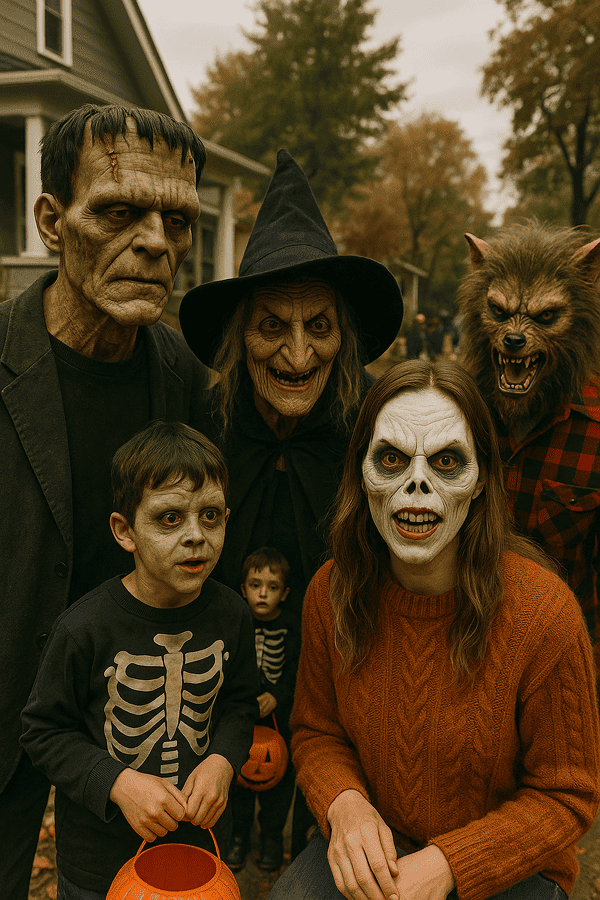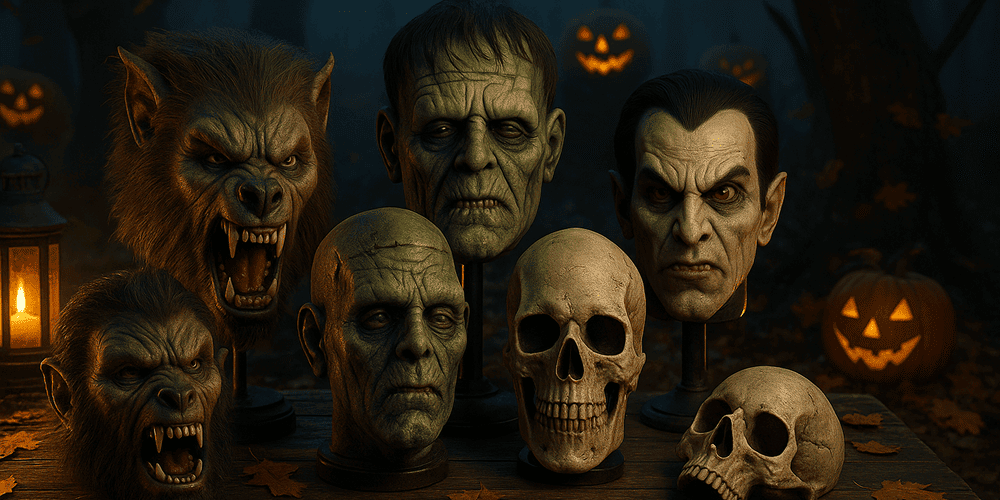Halloween Monster Masks are a defining symbol of modern Halloween celebrations, instantly recognizable for their grotesque, exaggerated, and imaginative designs. These masks transform wearers into legendary monsters — werewolves, vampires, mummies, zombies, Frankenstein’s creature, and more — with details like snarling fangs, bulging eyes, rotting flesh, or textured fur. Whether crafted from latex, silicone, plastic, or papier-mâché, Halloween Monster Masks are celebrated for their ability to evoke fear, delight, and creative self-expression. They are most closely associated with North American and European Halloween traditions but have become popular worldwide since the twentieth century, especially with the global rise of pop culture and horror cinema.
Historical Origins of Halloween Monster Masks
The origins of Halloween Monster Masks can be traced to ancient Celtic traditions, particularly the festival of Samhain, where people donned animal skins and scary faces to ward off wandering spirits. The word “monster” derives from the Latin “monstrum,” meaning portent or unnatural being, while “mask” comes from the Latin “masca,” meaning spirit or ghost. As Halloween evolved from All Hallows’ Eve and spread to North America, it absorbed European masquerade and folk traditions.
In the 19th and early 20th centuries, Halloween costumes were mostly handmade, often depicting spirits, animals, or folkloric monsters. The emergence of horror fiction, especially the works of Mary Shelley, Bram Stoker, and later Hollywood films, introduced iconic monsters to the public imagination. With the invention of latex and mass production in the 1930s and 1940s, monster masks became widely accessible, and characters like Dracula, the Wolfman, and the Mummy became Halloween staples. Don Post Studios and other companies revolutionized monster mask design, making them central to Halloween festivities, a tradition that continues alongside the popularity of Horror Masks.
Cultural Significance and Symbolism of Halloween Monster Masks
Halloween Monster Masks are powerful cultural symbols. They embody society’s fascination with the supernatural, the unknown, and the monstrous — allowing wearers to explore taboo, fear, and fantasy. In their native culture, monster masks transform the ordinary into the extraordinary, blurring the line between human and beast, life and death, humor and horror.
Spiritually and psychologically, these masks serve as tools for confronting and processing collective anxieties about mortality, evil, and the forces of chaos. By wearing a monster mask, participants can temporarily embody the “other,” gaining the freedom to act outside normal social boundaries. Myths and legends — from werewolves to vampires — are kept alive through the ritual of masking, while new monsters inspired by cinema and urban folklore are constantly added to the cultural repertoire. Socially, monster masks democratize the Halloween celebration, inviting everyone to participate in playful inversion and communal storytelling.
Materials and Crafting Techniques of Halloween Monster Masks
Traditional Halloween Monster Masks were made from papier-mâché, cloth, or carved wood, with simple paint and decorative features. Modern masks are typically crafted from latex, silicone, vinyl, or high-density foam, allowing for intricate sculpting, flexibility, and comfort. The mask-making process generally involves:
- Sculpting the original design in clay or digitally
- Creating a mold from plaster or silicone
- Casting the mask in latex or silicone
- Trimming, painting, and airbrushing for color and detail
- Adding hair, fur, teeth, or electronic effects (such as glowing eyes)
Special techniques include hand-painting, layering for texture, and embedding animatronic or lighting elements. Regional differences exist: American masks often focus on horror movie monsters, while European and Japanese monster masks may draw on local legends or kabuki theater. Color symbolism is essential: green for decay, red for blood, black for darkness, white for ghostliness, and yellow or orange for supernatural or diseased flesh. For more about mask-making and artist interviews, visit toddmasks.com.
Functions and Uses of Halloween Monster Masks
Halloween Monster Masks serve multiple functions:
- Ritual and Ceremonial Use: Echo ancient traditions of scaring away evil spirits or marking seasonal change.
- Theatrical and Performance Use: Central to haunted houses, horror theater, and festival performances.
- Festival and Holiday Use: Worn by trick-or-treaters, partygoers, parade participants, and in community events.
- Contemporary Use: Employed in horror conventions, cosplay, art installations, and even social media content.
Over time, the use of monster masks has shifted from ritual protection to entertainment, satire, and creative self-expression. Today, they are also used in virtual celebrations and as collectible art.

Regional Variations of Halloween Monster Masks
Regional variations reflect global influences and local folklore:
- North America: Features Hollywood-inspired monsters, zombies, and werewolves.
- United Kingdom: Includes classic gothic figures, witches, and ghostly apparitions.
- Mexico: Día de los Muertos masks blend monster motifs with calavera (skull) iconography.
- Japan: Monster masks draw on yokai and oni legends, with stylized teeth, horns, and expressive colors.
- Eastern Europe: Vampire and werewolf masks inspired by local myths and stories.
Local artists often incorporate unique cultural symbols, materials, or legends, making each region’s monster masks distinctive. Comparing these to Horror Masks and other ceremonial masks highlights both shared and unique traditions.
Famous Examples and Notable Collections of Halloween Monster Masks
Famous Halloween Monster Masks include:
- Classic Universal Monsters: Dracula, Frankenstein’s monster, Wolfman, and the Mummy masks, often seen in vintage collections.
- Don Post Studios: Known for pioneering hyper-realistic latex monster masks.
- Hollywood Movie Masks: Iconic designs from films like “An American Werewolf in London,” “The Exorcist,” and “Creature from the Black Lagoon.”
- Museum Collections: The Museum of Pop Culture (MoPOP, Seattle), The Hollywood Museum (Los Angeles), and private collections worldwide.
Temporary exhibitions, horror conventions, and online galleries (including toddmasks.com) celebrate the diversity and artistry of monster mask design.
Influence of Halloween Monster Masks on Art and Culture
Halloween Monster Masks have had a profound impact on visual art, fashion, film, and literature. Monster imagery is central to horror cinema, graphic novels, and video game design. Artists such as Rick Baker and Tom Savini have elevated monster mask creation to high art, winning awards for their realistic and imaginative designs.
In music, bands use monster masks to create stage personas; in literature, masks symbolize duality, hidden identity, and the boundary between human and monster. Fashion designers frequently draw on monster motifs for Halloween collections and runway shows. The preservation of monster mask traditions ensures that these symbols continue to inspire and challenge cultural definitions of fear and fun.
Contemporary Status and Preservation of the Monster Mask Tradition
Today, master mask-makers and independent studios continue to innovate, using new materials, digital sculpting, and interactive features. Modern mask-making communities share techniques online, offer tutorials, and participate in global competitions. Workshops, school programs, and Halloween events ensure the tradition remains vibrant.
Eco-friendly materials, 3D printing, and smart technology are shaping the future of monster masks. Organizations like toddmasks.com play a crucial role in documenting, teaching, and celebrating the monster mask tradition, connecting collectors, artists, and enthusiasts worldwide.
Collecting and Acquiring Halloween Monster Masks
The collecting market for monster masks is thriving, with options ranging from mass-market masks to rare, artist-signed pieces. Authentic masks can be found at specialty shops, horror conventions, auctions, and reputable online platforms like toddmasks.com. Prices depend on material, craftsmanship, rarity, provenance, and association with famous films or artists.
Collectors should seek quality materials, original designs, and documentation. Supporting living artisans and ethical acquisition is important, as is avoiding counterfeits and respecting copyright. Toddmasks.com provides expert advice on authentication, valuation, and responsible collecting.
